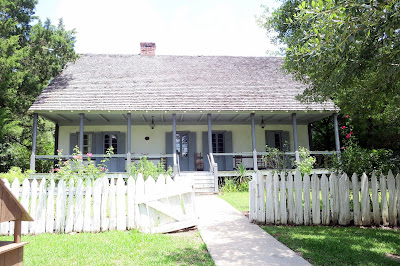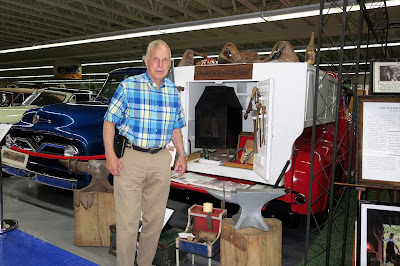In 2016, we joined an RV caravan to the Maritime Provinces of Canada. In Nova Scocia, I learned the beginning of the story of the Acadian people and about the Great Expulsion. I was shocked that I had never heard of this before. A possible excuse being that this was Canadian history not American history (that's an oxymoron for sure). You can research the terrible tale of the Great Expulsion on your own. One of the many ends to that tale is here in 'Cajun Country'.
I wanted to learn more and I certainly wanted to have some 'Cajun Cooking'. A couple days in Lafayette, LA would do it. So I built a two day stop here in Lafayette into our travel schedule.
"Lafayette is considered to be the center of Acadiana, the area of Cajun and Louisiana Creole culture in the state. It developed following the relocation of Acadians after their expulsion by the British from eastern Canada in the late 18th century following France's defeat in the Seven Years' War. There is also a strong Louisiana Creole influence in the area, as this mixed-race population became landowners and businesspeople."Wikipedia
So what is the difference between Cajun and Creole? I'm sure this won't help a bit.
Cajuns identify themselves as descendants of Acadian refugees.
Creole derives from the Spanish and Portuguese words criollo/criolo, which referred to someone born in the Americas during the colonial period. Creole is a term still used throughout Latin America and the Caribbean to describe local indigenous culture and people. In Louisiana, the term often describes the blending of French, African, Native American, and Spanish people and traditions, as well as those people of French or Spanish descent who are not Cajun. In southwest Louisiana, the term can refer more specifically to people of African descent who have French, Spanish, and/or Native American heritage.
Wikipedia says this about Creole: "In the United States, the word 'Creole' refers to people of any race or mixture thereof who are descended from colonial French La Louisiane and colonial Spanish Louisiana (New Spain) settlers before the Louisiana region became part of the United States in 1803 with the Louisiana Purchase. Both the word and the ethnic group derived from a similar usage, which began in the 16th Century, in the Caribbean that distinguished people born in the French, Spanish, and Portuguese colonies from the various new arrivals born in their respective, non-Caribbean homelands."
I blockquoted this entire discussion to be sure no one gets the idea that I invented this mess. Only the first sentence makes sense. Cajuns know who they are. I don't know how anyone could possibly decide whether or not they are Creole.
This morning we visited Vermilionville Historic Village – a Cajun and Creole living history museum with restored historic structures.
The village consists of quite a few restored structures representing the history of the area. I'll mention two.
Broussard House
Maison Broussard (Broussard House): A Large Acadian Plantation Home
The Broussard House dates to 1790 and is the oldest building in Vermilionville. Built in the French Creole style, it was the home of Armand Broussard, who immigrated to Louisiana as a child from Acadian Canada. Armand was the son of Joseph "Beausoleil" Boussard, the famous Acadian resistance fighter who brought over two hundred Acadian refugees from Canada to the Poste des Attakapas in 1765. At the age of sixteen, Armand registered his first cattle brand, and eventually became a prosperous rancher with his wife Anne Benoit and their fourteen children. Broussard was also a military veteran who served in both the American Revolution and at the Battle of New Orleans in 1815.
The Broussard Plantation like most large farming operations used slave labor. Enslaved persons in southwest Louisiana were a culturally diverse group, comprised of native-born Africans of numerous different ethnic groups from across western and central Africa, French-speaking Creole persons of color, and English-speaking persons of color from the eastern states. Enslaved workers performed skilled jobs in the construction trades, blacksmithing, cattle droving, laundering and cooking, as well as less skilled jobs such as field hands and general labor.
Boucvalt House
Maison Boucvalt (Boucvalt House): An Urban Dwelling from the late 1800s
This house was originally located in downtown Opelousas. The house is named after the last owner, Dr. Roy Boucvalt Jr.
The house is an example of Acadian/Creole architecture with some Victorian characteristics. Creole design includes the use of adjoining rooms with no central hallway. The layout centers on a large living area flanked by bedrooms. Transom windows above the doors allowed ventilation to induce cooling air while also allowing closed-door privacy. The large porch offered protection from the sun and rain, and the louvered shutters blocked harsh sunlight while allowing airflow for a cooling effect. Victorian features include the decorative balusters and elaborate column capitals.
The village includes a restaurant that was not open when we visited.
La Cuisine de Maman Restaurant
La Cuisine de Maman Restaurant
That turned out to be OK because unknown to us at the time we would return to this very spot this afternoon on our Food Tour
OUR CAMPGROUND
Lafayette KOA
537 Apollo Road
Scott, LA 70583
GPS: 30.246756o, -092.111321o
###
Light fiction here at Opuscule






















































































